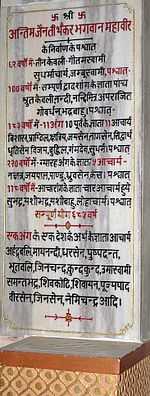Kundakunda
<th class="" style="padding:0.1em;;padding:0.5em 0 0.1em 0; font-size:120%; color: white; line-height:1.0em; style="text-align:center; background: #EEEEEE;;">
Jain Prayers<th class="" style="padding:0.1em;;padding:0.5em 0 0.1em 0; font-size:120%; color: white; line-height:1.0em; style="text-align:center; background: #EEEEEE;;">
Philosophy<th class="" style="padding:0.1em;;padding:0.5em 0 0.1em 0; font-size:120%; color: white; line-height:1.0em; style="text-align:center; background: #EEEEEE;;">
Major figures<th class="" style="padding:0.1em;;padding:0.5em 0 0.1em 0; font-size:120%; color: white; line-height:1.0em; style="text-align:center; background: #EEEEEE;;">
Major Sects<th class="" style="padding:0.1em;;padding:0.5em 0 0.1em 0; font-size:120%; color: white; line-height:1.0em; style="text-align:center; background: #EEEEEE;;">
Texts<th class="" style="padding:0.1em;;padding:0.5em 0 0.1em 0; font-size:120%; color: white; line-height:1.0em; style="text-align:center; background: #EEEEEE;;">
Other<th class="" style="padding:0.1em;;padding:0.5em 0 0.1em 0; font-size:120%; color: white; line-height:1.0em; style="text-align:center; background: #EEEEEE;;">
Festivals| Part of a series on |
| Jainism |
|---|
 |
|
|
|
Kundakunda (also Kundkund) is a celebrated Jain Acharya, Jain scholar monk, 2nd century CE, composer of spiritual classics such as: Samayasara, Niyamasara, Panchastikayasara, Pravachansara, Atthapahuda and Barasanuvekkha. He occupies the highest place in the tradition of the Jain acharyas.
He belonged to the Mula Sangh order. His proper name was Padmanandi, he is popularly referred to as Kundakunda because he was born in a place named Kaundakunda in south India. He is closely associated with the Digambara sect, also in recent decades, his books have become popular among Svetambaras also. He was known also as:
- Padmanandi
- Elacarya
- Vakragriva
- Grddhapiccha
For Digambaras, his name has auspicious significance and occupies third place after Bhagavan Mahavira and Gautama Ganadhara in the sacred litany. Kundakunda's singular contribution consists in his compiling a number of liturgical tracts and creating several masterly doctrinal works of his own, which provided a parallel canon for the Digambara tradition. This earned him the everlasting gratitude of the Digambaras, who have for centuries invoked his name together with that of Mahavira and his chief ganadhara Indrabhuti Gautama, placing him ahead even of Bhadrabahu, Visakha, and some forty other elders (sthaviras ) in the lineage, thus making him virtually the founder of the Digambara sect.[1]
Works

The works attributed to Kundakunda, all of them in Prakrit, can be divided in three groups. The first group is a collection of ten bhaktis (devotional prayers), short compositions in praise of the acaryas (Acaryabhakti ), the scriptures (Srutabhakti ), the mendicant conduct (Caritrabhakti ), and so forth. They form the standard liturgical texts used by the Digambaras in their daily rituals and bear close resemblance to similar texts employed by the Svetambaras, suggesting the possibility of their origin in the canonical period prior to the division of the community. The second group comprises four original works described as "The Essence" (sara )— namely, the Niyamasara (The Essence of the Restraint, or the mendicant discipline, in 187 verses), the Panchastikayasara (The Essence of the Five Existents, in 153 verses), the Samayasara (The Essence of Self-Realization, in 439 verses), and the Pravachanasara (The Essence of the Teaching, in 275 verses), all of which, because of their nonconventional or absolute (nischayanaya ) approach, have exerted a tremendous influence not only on the Digambara psyche but, as will be seen in Chapter VI, even on some of the leading members of the Shvetambara community, both old and new. The last group consists of eight short texts called Prabhrta (Pkt. pahuda, i.e., a gift or a treatise), probably compilations from some older sources, on such topics as the right view (Darsanaprabhrta, in 36 verses), right conduct (Caritraprabhrta, in 44 verses), the scripture (Sutraprabhrta, in 27 verses), and so forth. Dr. A. N. Upadhye in his critical edition of the Pravachansara has examined at great length the problems concerning the date and author-ship of these and other works attributed to Kundakunda and has placed him in the middle of the 2nd century AD.[2]
Kundakunda wrote in Shauraseni Prakrit. Amongst the modern followers of Kundakunda, three names are remarkable, Banarasidasa, a 16th-century lay poet from Agra who began his spiritual quest after reading kundakunda's "Samayasara"; Rajachandra, the Gujarati merchant who trod famously on the spiritual path highlighted by Acharya Kundakunda; and Kanji Swami who converted from Shwetambar Monk to a Digamabar follower and preached Kundkund's "Samaysara" and other books passionately for fifty years.
Beliefs
It is believed that Acharya Kundkund was knowing the Avakashgamini vidya (Skill to teleport self through air). He went to videh kshetra where Simandhar swami's samav sharan was going. Height of acharyas there was so huge that Kundkund looked like cardamom size in front of them. Hence those acharyas called him "Elacharya" (Cardamom sized acharya). Acharya Kundkund gained knowledge directly from Tirthankara Shri Simandhar Swami and created the "Samaysaar".
It has been written in various Jain literature that Aacharya Kundkund has written '84 Pahurs' but most of them are missing time by time. The most famous of them is 'Samaya Pahur' also known as 'SamayaSaar'. Other than this are Pravachanpahur, Ashtapahur, Lingpahur, Sheelpahur, Niyampahur etc.
See also
References
- ↑ Jaini, Padmanabh (1991). Gender and Salvation: Jaina Debates on the Spiritual Liberation of Women. Berkeley: University of California Press. p. 32.
- ↑ Jaini, Padmanabh (1991). Gender and Salvation: Jaina Debates on the Spiritual Liberation of Women. Berkeley: University of California Press. pp. 32–33.
External links
|